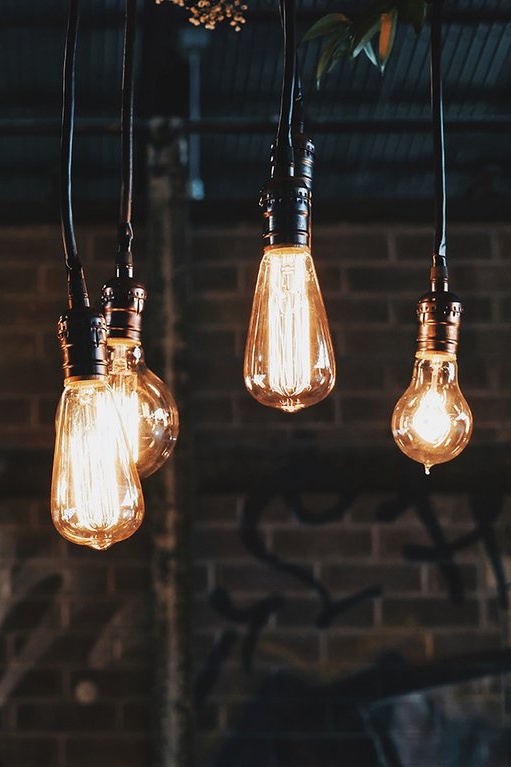
Lighting Glossary
- A
- Accent lighting
Accent lighting is the alignment of light sources with one or more objects in a room. Narrow-beam lights, e.g. ceiling installations, or surface-mounted ceiling lights can be used for accent lighting. Point light sources (halogen bulbs, low-voltage, high-voltage and LEDs) may be used as light sources. The lights should be individually adjustable, as the location of objects in rooms usually varies.
-
- B
- Base
The base is the part of the light source that establishes the mechanical and electrical contact with a socket. It attaches the light source to the light. The types of bases include E14, E27, GU10, GU5.3 etc.
- Beam angle
The beam angle indicates the size of the light beam generated by a lamp. The higher the beam angle, the larger the directly illuminated area.
-
- C
- Color reproduction (RA value)
The color reproduction index (RA or CRI) describes the color reproduction, therefore providing information about the light quality. In other words, it indicates how realistic the color reproduction of an illuminated object will be underneath the requisite light source. The highest color reproduction value is RA = 100 (sunlight). A light source of this value allows all colors within our environment to appear at their most natural. The lower the RA value, the lower the quality of the color reproduction of the illuminated object will be.
The European Union (EU) stipulates that the color reproduction index of LEDs must be at least 80 RA. Technically, it is now possible to produce LEDs with RA values of greater than 90. However, these consume more energy. Therefore, an RA value of 80 is permissible for normal usage such as workplace lighting. In the case of jobs that require an accurate level of color perception (hairdressers, printing shops), light sources with RA values of at least 90 are recommended.
- Color temperature
Color temperature describes the color of a light source. The color temperature is given in kelvins, but appears to be warmer the lower the value is. Neutral white light has a color temperature of 3300 to 5300 K. If the color temperature is below 3300 K then the light is warmer, while it is colder if the temperature is above 5300 K. The color temperature provides information about the light color, but not the color’s quality or reproduction. As a general rule of thumb: The higher the kelvin value, the cooler and whiter the light. Conversely, the lower the kelvin value, the warmer the light.
Cold white light and daylight white is cool, sober and exudes a bluish hue. This has a stimulating effect and boosts the concentration, making it perfect for work (office).
Neutral white light is neutral and sober, and has little influence on a room’s ambiance. Therefore, this color temperature is strongly recommended for use in the kitchen or bathroom.
Warm white light has a pleasant, comfortable and dimming effect. It has a yellowish appearance (similar to a sunset) and is therefore perfect for evenings spent relaxing in the living room.
-
- D
- Dimmer
A dimmer is used to adjust the luminous flux of a light source. With this, the brightness is either reduced or increased.
-
- E
- Energy efficiency class
Light sources are also categorized according to their energy efficiency class. The energy efficiency is determined by the light emitted (luminous flux, lumen units) as per the power consumption in watts. The A+ energy efficiency class indicates high energy efficiency, while G indicates an extremely low one.
-
- F
- Flickering
Flickering is when the appearance of a beam of light from a light source starts changing rapidly. This effect is highly bothersome to observers and may also be unconsciously perceived. The dimming of LEDs makes this effect occur more frequently.
-
- I
- Illumination level
Illumination level is measured in Lux (lx) and has a significant influence on how quickly and easily a challenging visual task (e.g. reading) can be performed by our eyes. It describes the quantity of light that hits a surface (e.g. a book or writing desk). A high illumination level is therefore required if, for example, you enjoy reading or work at home.
-
- K
- Kelvin
Kelvin (K) is the unit of measurement for color temperature.
-
- L
- LED
LED is the acronym for “light-emitting diode”. They are semiconductor devices that have the same electrical properties as a diode. If the electrical current flows through the diode in a forward direction, the light, infrared radiation or ultraviolet radiation will be emitted with a wavelength dependent on the semiconductor material and doping.
- Lifetime
Unfortunately, it is not possible to test how long each product will last. Therefore, the indicated lifetime is the average lifetime. For LEDs, the average lifetime is the time from which the lamp is switched on for the first time to the point when only 50% of the tested lamps are still functioning flawlessly.
- Luminous efficiency
Luminous efficiency (lumens per watt) refers to the efficiency of lamps. The more light (lumens) produced per the energy/power (watts) consumed, the lower the costs and the higher the efficiency.
- Luminous flux
Lumen (lm) is the unit of measurement for luminous flux. It indicates the brightness of light that is output in various directions by a light source and rated in accordance with the internationally stipulated sensitivity of the human eye.
-
- M
- Moisture-proof lights
Moisture-proof lights are lights whose design prevents moisture from penetrating into their interior (at least IP44). As the designation of “moisture-proof light” is unspecific, each light comes labeled with its protection class. The protection class indicates the level of protection provided against moisture penetration.
-
- P
- Power consumption
Power consumption describes the amount of electrical energy required by an electrical device within a specific period of time. It is also referred to as current consumption or demand.
-
- W
- Watt
Watt (W) is the physical measuring unit for power or power consumption. It was named after James Watt, the Scottish scientist and engineer.
-

We take a personal
interest in your needs.
To us, "full service" means that we are always there for you in person. You need recommendations for your product range? You are looking for top-quality brand-name products for your end customers? You need assistance with your product or POS concept? We are here to help you!
Make contact